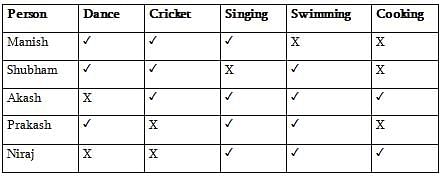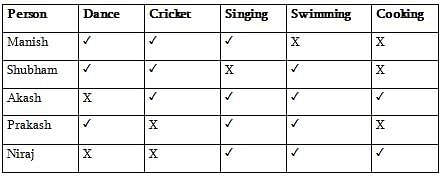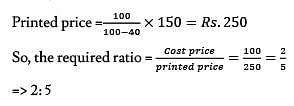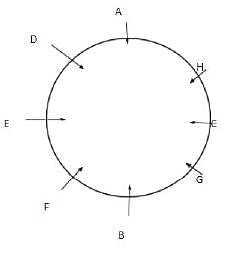UKPSC Prelims Paper 2 Mock Test - 3 - UKPSC (Uttarakhand) MCQ
30 Questions MCQ Test UKPSC Mock Test Series 2024 - UKPSC Prelims Paper 2 Mock Test - 3
Direction for: Each of the following questions is based on the following information:
1. Six flats on a floor in two rows facing North and South are allotted to P, Q R, S, T and U.
2. Q gets a North facing flat and is not next to S.
3. S and U get diagonally opposite flats.
4. R next to U, gets a south facing flat and T gets North facing flat.
The flats of which of the other pairs than SU, is diagonally opposite to each other?
Virtually everything astronomers known about objects outside the solar system is based on the detection of photons—quanta of electromagnetic radiation. Yet there is another form of radiation that permeates the universe: neutrinos. With (as its name implies) no electric charge, and negligible mass, the neutrino interacts with other particles so rarely that a neutrino can cross the entire universe, even traversing substantial aggregations of matter, without being absorbed or even deflected. Neutrinos can thus escape from regions of space where light and other kinds of electromagnetic radiation are blocked by matter. Furthermore, neutrinos carry with them information about the site and circumstances of their production: therefore, the detection of cosmic neutrinos could provide new information about a wide variety of cosmic phenomena and about the history of the universe.
According to the passage, one advantage that neutrinos have for studies in astronomy is that they
| 1 Crore+ students have signed up on EduRev. Have you? Download the App |
Directions: Study the following information carefully and answer the questions that follow.
Manish and Shubham are good in Dance and Cricket. Akash and Manish are good in Cricket and Singing. Akash, Prakash and Niraj are good in Singing and Swimming. Niraj and Akash are good in Singing and Cooking. Prakash and Shubham are good in Swimming and Dance.
Who is good in Singing, Dance and Cricket?
Directions: Study the following information carefully and answer the questions that follow.
Manish and Shubham are good in Dance and Cricket. Akash and Manish are good in Cricket and Singing. Akash, Prakash and Niraj are good in Singing and Swimming. Niraj and Akash are good in Singing and Cooking. Prakash and Shubham are good in Swimming and Dance.
Who is good in Singing, Swimming and Cooking but not in Cricket?
Despite the best efforts of those responsible for preventing fraud, one inevitable reality remains: “fraud happens.” Because fraud and misconduct can occur at various levels in any organization, it is essential that appropriate preventive and detective techniques are in place. Although fraud prevention and detection are related concepts, they are not the same. While prevention encompasses policies, procedures, training, and communication, detection involves activities and programs designed to identify fraud or misconduct that is occurring or has occurred. Although preventive measures cannot ensure that fraud will not be committed, they are the first line of defence in minimizing fraud risk. One key to prevention is making personnel throughout the organization aware of the fraud risk management program, including the types of fraud and misconduct that may occur. This awareness should enforce the notion that all of the techniques established in the program are real and will be enforced. The ongoing communication efforts could provide information on the potential disciplinary, criminal, and civil actions that the organization could take against the individual. With this in mind, prevention and deterrence are interrelated concepts. If effective preventive controls are in place, working, and well-known to potential fraud perpetrators, they serve as strong deterrents to those who might otherwise be tempted to commit fraud. Fear of getting caught is always a strong deterrent. Effective preventive controls are, therefore, strong deterrence controls.
How the HR department of an organization can play a vital role in the prevention of fraud in the company?
Study the following table and answer the question based on it.
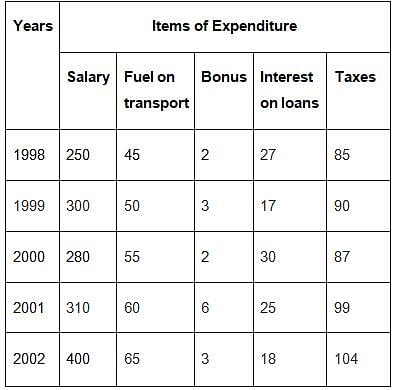
Expenditures of a Company (in Lakh Rupees) per Annum Over the given Years
The total amount of bonus paid by the company during the given period is approximately what percent of the total amount of salary paid during this period?
if the HCF of two numbers (each greater than 15) be 15 and LCM be 315, then the sum of numbers will be
A certain number when divided by 247 leaves a remainder 17, another number when divided by 361 leaves a remainder 52. What is the remainder when the sum of these two numbers is divided by 19?
Milankovitch proposed in the early twentieth century that the ice ages were caused by variations in the Earth’s orbit around the Sun. For some time, this theory was considered untestable, largely because there was no sufficiently precise chronology of the ice ages with which the orbital variations could be matched. To establish such a chronology, it is necessary to determine the relative amounts of land ice that existed at various times in the Earth’s past. A recent discovery makes such a determination possible: relative land-ice volume for a given period can be deduced from the ratio of two oxygen isotopes, 16 and 18, found in ocean sediments. Almost all the oxygen in water is oxygen 16, but a few molecules out of every thousand incorporate the heavier isotope 18.
When an ice age begins, the continental ice sheets grow, steadily reducing the amount of water evaporated from the ocean that will eventually return to it. Because heavier isotopes tend to be left behind when water evaporates from the ocean surfaces, the remaining ocean water becomes progressively enriched in oxygen 18. The degree of enrichment can be determined by analyzing ocean sediments of the period, because these sediments are composed of calcium carbonate shells of marine organisms, shells that were constructed with oxygen atoms drawn from the surrounding ocean. The higher the ratio of oxygen 18 to oxygen 16 in a sedimentary specimen, the more land ice there was when the sediment was laid down.
According to the passage, which of the following is true of the ratios of oxygen isotopes in ocean sediments?
Milankovitch proposed in the early twentieth century that the ice ages were caused by variations in the Earth’s orbit around the Sun. For some time, this theory was considered untestable, largely because there was no sufficiently precise chronology of the ice ages with which the orbital variations could be matched. To establish such a chronology, it is necessary to determine the relative amounts of land ice that existed at various times in the Earth’s past. A recent discovery makes such a determination possible: relative land-ice volume for a given period can be deduced from the ratio of two oxygen isotopes, 16 and 18, found in ocean sediments. Almost all the oxygen in water is oxygen 16, but a few molecules out of every thousand incorporate the heavier isotope 18.
When an ice age begins, the continental ice sheets grow, steadily reducing the amount of water evaporated from the ocean that will eventually return to it. Because heavier isotopes tend to be left behind when water evaporates from the ocean surfaces, the remaining ocean water becomes progressively enriched in oxygen 18. The degree of enrichment can be determined by analyzing ocean sediments of the period, because these sediments are composed of calcium carbonate shells of marine organisms, shells that were constructed with oxygen atoms drawn from the surrounding ocean. The higher the ratio of oxygen 18 to oxygen 16 in a sedimentary specimen, the more land ice there was when the sediment was laid down.
It can be inferred from the passage that precipitation formed from evaporated ocean water has
Of the 1300 candidates, who were interviewed for a position at a Bank, 900 had a Car, 630 had a motorcycle and 690 had a mobile phone. 300 of them had both, a Car and a motorcycle, 230 had both, a motorcycle and a mobile phone and 360 had both, a Car and mobile phone and 100 had all three. How many candidates had none of the three?
In a college, 12% of total students are interested in chess. 3/4 of the total students are interested in hockey. 10 % of the remaining students are interested in singing and the remaining 117 are interested in dancing. How many students are there in college?
Rehman earns a profit of 50% on selling a knife at 40% discount on the printed price. The ratio of Cost price and the printed price is:
In a poor country like India, as income rises people first concentrate on increasing their consumption of what they regard as basic or more essential consumer goods. For the poor, these goods would primarily include cereals and for people at successive levels of higher income protective foods, simple non-food consumer goods, more modern, better quality non-food consumer goods and simple consumer durables, better quality consumer goods, and so on. When the demand for basic and more essential consumer goods is more or less met, demand for the next higher level of consumer goods begins to impinge on consumer decision making and their consumption increases. There is thus a hierarchy of income levels and a hierarchy of consumer goods. As incomes rise and one approaches the turning point referred to, there is an upward movement along the hierarchy in the demand for consumer goods which exhibits itself in a relative increase in the demand for these goods. If one examines the past consumption behaviour of households in India, one finds confirmation of the proposition just made. Until the mid seventies one notices a rise in the proportion of consumption expenditure on cereals, and thereafter, a steady decline reflecting a progressive increase in the relative expenditure on non-cereal or protective foods. About the same time the rising trend in the share of food in total consumption expenditure also begins to decline, raising the proportion of expenditure on non-food consumer goods. Simultaneously one also notices a sharper rise in the proportion of expenditure on consumer durables. Thus, what one sees is an upward movement in consumer demand along the hierarchy of consumer goods which amounts to a major change in consumer behaviour.
As income rises in a poor country like India, the poor people concentrate on increasing their consumption of
In a poor country like India, as income rises people first concentrate on increasing their consumption of what they regard as basic or more essential consumer goods. For the poor, these goods would primarily include cereals and for people at successive levels of higher income protective foods, simple non-food consumer goods, more modern, better quality non-food consumer goods and simple consumer durables, better quality consumer goods, and so on. When the demand for basic and more essential consumer goods is more or less met, demand for the next higher level of consumer goods begins to impinge on consumer decision making and their consumption increases. There is thus a hierarchy of income levels and a hierarchy of consumer goods. As incomes rise and one approaches the turning point referred to, there is an upward movement along the hierarchy in the demand for consumer goods which exhibits itself in a relative increase in the demand for these goods. If one examines the past consumption behaviour of households in India, one finds confirmation of the proposition just made. Until the mid seventies one notices a rise in the proportion of consumption expenditure on cereals, and thereafter, a steady decline reflecting a progressive increase in the relative expenditure on non-cereal or protective foods. About the same time the rising trend in the share of food in total consumption expenditure also begins to decline, raising the proportion of expenditure on non-food consumer goods. Simultaneously one also notices a sharper rise in the proportion of expenditure on consumer durables. Thus, what one sees is an upward movement in consumer demand along the hierarchy of consumer goods which amounts to a major change in consumer behaviour.
Prices of protective food have risen because
Direction: Six members of a family P, Q, R, S, T and U. There are two couples each having one unmarried child in the family. Each has a profession namely Doctor, Musician, Actor, Engineer, Pilot and Soldier not in the same order as written.
1. R is father of Soldier
2. Pilot marries T, who is neither Engineer nor Soldier
3. Q is a doctor and married to an Engineer
4. U, the son of Pilot is an Actor
5. P is neither a soldier nor an Engineer.
6. R and P are brothers
What is the occupation of P?
Directions: The following table shows the marks obtained by 100 students in Mathematics, Science and the average of the two subjects.
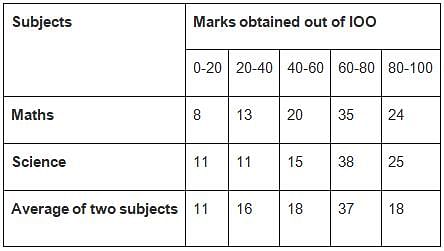
Find the number of students who got 60% or more marks in both subjects.
Directions: The following table shows the marks obtained by 100 students in Mathematics, Science and the average of the two subjects.
If to qualify in the examination one has to secure a minimum of 60% marks in both subjects, find the maximum number of students who have qualified the examination.
According to Bruce Hoffman, an American specialist on political violence, old terrorism generally had a specific manifesto-to overthrow a colonial power or the capitalist system and so on. These terrorists were not shy about planting a bomb or hijacking an aircraft and they set some limit to their brutality. Killing so many innocent people might turn their natural supporters off. Political terrorists want a lot of people watching but not a lot of people dead. “Old terrorism sought to change the world while the new sort is often practised by those who believe that the world has gone beyond redemption”, he added. Hoffman says, “New terrorism has no long-term agenda but is ruthless in its short-term intentions. It is often just a cacophonous cry of protest or an outburst of religious intolerance or a protest against the West in general and the US in particular. Its perpetrators may be religious fanatics or die hard opponent of a government and see no reason to show restraint. They are simply intent on inflicting the maximum amount of pain of the victim.”
Which of the following statements is true about new terrorism?
It is an old saying that knowledge is power. Education is an instrument which imparts knowledge and, therefore, indirectly controls power. Therefore, ever since the dawn of civilization persons in power have always tried to supervise or control education. It has been the handmaid of the ruling class. During the Christian era, the ecclesiastics controlled the institution of education and diffused among the people the gospel of the Bible and religious teachings. These gospels and teachings were no other than a philosophy for the maintenance of the existing society. It taught the poor man to be meek and to earn his bread with the sweat of his brow, while the priests and the landlords lived in luxury and fought duels for the slightest offense.
Why have persons in power always tried to supervise or control education?
Excluding stoppages, the speed of a bus is 54 kmph and including stoppages, it is 45 kmph. For how many minutes does the bus stop per hour?
A, B, C, D, E, F and G are members of a family consisting of four adults and three children, two of whom, F and G are girls. A and D are brothers and A is a doctor. E is an engineer married to one of the brothers and has two children. B is married to D and G is their child. Who is C?
Find the value of expression 98-99+100-101+102-103+ 998 - 999 + 1000
Adam, Boris and Khan start from the same place and travel in the same direction at speeds of 15, 30 and 60 km per hour respectively. Boris starts two hours after Adam. If Boris and Khan overtake Adam at the same instant, how many hours after Adam did Khan start?
A wine seller had three types of wine. 435 litres of 1st kind, 609 litres of 2nd kind and 290 litres of 3rd kind. Find the least possible number of casks of equal size in which different types of wine can be filled without mixing.
By religion, I do not mean formal religion, or customary religion, but the religion which underlies all religions, which bring us face to face with our maker. Let me explain what I mean by religion. It is not the Hindu religion which I certainly prize above all other religions, but the religion which transcends Hinduism, which changes one very nature, which binds one indissolubly to the truth within and which ever purifies. It is the permanent element in human nature which counts no cost too great in order to find full expression and which leaves the soul utterly restless until it has found itself, known its maker and appreciated the true correspondence between the Maker and itself. I have not seen him, neither have I known Him. I have made the world’s faith in God my own, and as my faith is ineffaceable, I regard that faith as amounting to experience. However, as it may be said that to describe faith as experience is to tamper with truth, it may perhaps be more correct to say that I have no word for characterizing my belief in God. There is an independent mysterious Power that pervades everything. I feel it, though I do not see it. It is the unseen power which makes itself and yet defies all proofs because it is so unlike all that I perceive through my senses. It transcends the senses. But it is possible to reason out the existence of God to a limited extent.
Which of the following elements would be present in the author’s concept of religion?
1. It is a reflection of the truth within.
2. It may or may not be present in human nature.
3. It transcends the customary and formal religion.
4. It seeks the maker.
5. Its characteristics undergo change with time and place.
6. It transcends Hinduism.
Direction: A, B, C, D, E, F, G and H members of the family. Sitting around a table facing the center. There are 3 generations and there are 2 married couples and the rest are children of the 2nd generation. A the grandchild of E sits immediate right to his grandmother D. B and G, daughters of C sit between their parents. H the son of F but F is not his mother, sits between his sister and his mother and he is immediately right to his mother. A’s mother is sitting between her only son and one daughter G.
E is sitting immediately right?
If A + B means A is the father of B; A - B means A is the brother B; A % B means A is the wife of B and A x B means A is the mother of B, which of the following shows that M is the maternal grandmother of T?
If TOUR is written as 1234, CLEAR is written as 56784 and SPARE is written as 90847, find the code for CARE
Ganguly has a certain average for 4 innings. In the 5th inning, he scores 40 runs thereby increasing his average by 4 runs. His new average is
|
20 tests
|
|
20 tests
|




